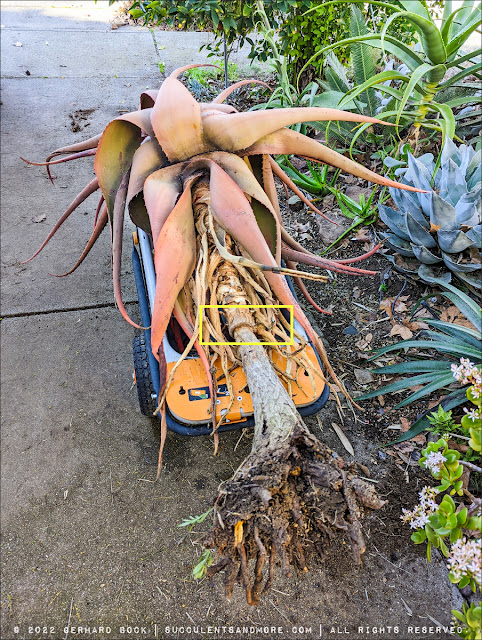Aloe excelsa removed, diagnosed, treated, and convalescing
Over the last year or so, I've periodically shown photos of our Aloe excelsa, located in the long L-shaped bed along the sidewalk. While it's common for this species to assume a reddish hue in the winter, it should revert to green in the summer, especially when watered. Ours has been stuck on red for a year and half now, prompting this recent comment by a reader:
“[Y]our excelsa is definitely having issues. It should green up in summer and only take on color in the cooler season. There’s healthy red on plump leaves and then there’s death throes red on a starved, declining plant. My guess is either this is a living crown on a dead stem (tree-type aloe stems seem to be more frost sensitive than the crown) or there aren’t much feeder roots and only anchoring roots. It just seems like it’s not taking up water at all. You might inspect around the crown in the dead leaves for aerial roots trying to make their way down to the soil. If you find them, that stem is indeed dead.”
JM, the commenter, is right, of course. Something bad is going on, and I finally decided to get to the bottom of it.
Below is Aloe excelsa on January 8, 2022. It's easy to see why a passer-by asked me recently if it was a copper sculpture!
 |
| January 8, 2022 |
The aloe was held in place by a ratchet tie-down strap connected to a spiral ground anchor. As you can see in the video below, the aloe fell over as soon as I released the strap. This is exactly what I had expected would happen.
Reader JM had been correct: The stem had rotted at the base.
My wife and I loaded the fallen aloe onto a cart and I wheeled it into the driveway.
Upon inspection, it became clear that the base had rotted quite a while ago. I don't know when it happened or why, and speculating is moot.
Using a hand saw, I cut off the bottom of the stem at the highlighted line:
Unfortunately, the rot had progressed further up the stem than the spot where I had made the cut:
In total, I removed 27 inches of stem, leaving about 13 inches:
After trimming off most of the older leaves, I placed the stem in a 5-gallon pot filled with pure pumice and leaned it up against the house:
This is where it'll be until it's formed a healthy amount of new roots—a process that will take well into the summer. After that, it will be planted in the ground again.
Hopefully by this time next year, it will be ready to flower once more, although it will be years before it will look like this again:
 |
| Aloe excelsa almost two years ago, March 2020 |
NOTE ON RE-ROOTING PROCESS:
- Since temperatures right now are in the 40s at night and in the high 50s/low 60s during the day, I'm keeping the pumice dry. Once day-time temperature are reliably in the 60s or higher, I'll lightly wet the pumice and then repeat it every 3 weeks.
- My plan is to check for roots after 6 weeks.
- If there are roots, I'll move the aloe to a well-drainage mix (50% cactus mix, 50% pumice).
- If there are no roots, I'll put the stem back in the pot with 100% pumice.
- If there are no roots after 6 months, I'll be ready to give up and consider the aloe dead.
© Gerhard Bock, 2022. All rights reserved. To receive all new posts by email, please subscribe here.









I hope the Aloe comes through this experience stronger than ever, Gerhard! Kudos to M for expressing concern and to you for following up.
ReplyDeleteAloe excelsa is a beautiful aloe and not exactly common in cultivation. I really do want to save it. I kick myself for not having sprung into action sooner.
DeleteI’ve just had a very similar issue with my aloe Sabella. I appreciate you sharing your experience. The question I have is, do you water it while it is rooting in pumis?
ReplyDeleteI added a new note at the end of my original post. See above under "Note on re-rooting process."
DeleteGood luck with your Aloe sabaea!
Beautiful species, hopefully you caught it in time. If not, lesson learned. We don't always spring to a plant's aid as fast as we should, but with many many plants and a life outside of them as well, it happens.
ReplyDeleteWhen I saw you plop this magnificent coppery Aloe into the wheelbarrow, my heart sank. And then, surprise: there is still a chance for rejuvenation. There is no end to a plant's desire to live on and I hold on to hope you and it will succeed.
ReplyDeleteCutting back the trunk to find clean tissue really brought back memories! My guess is it should reroot again in the pumice, with the big question remaining what caused the initial decline? Instinctively I would aim for giving it more breathing room and sun at its base and its own watering basin -- maybe the close quarters wasn't to its liking? It's still a very beautiful invalid while it recovers. And kudos to JM's sharp eye and excellent diagnostic skills!
ReplyDelete